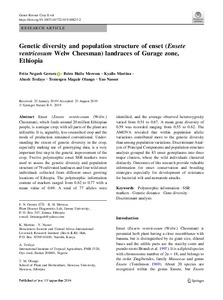| dc.contributor.author | Gerura, F.N. |
| dc.contributor.author | Meressa, B.H. |
| dc.contributor.author | Martina, K. |
| dc.contributor.author | Tesfaye, A. |
| dc.contributor.author | Olango, T.M. |
| dc.contributor.author | Nasser, Y. |
| dc.date.accessioned | 2020-06-04T12:20:59Z |
| dc.date.available | 2020-06-04T12:20:59Z |
| dc.date.issued | 2019 |
| dc.identifier.citation | Gerura, F.N., Meressa, B.H., Martina, K., Tesfaye, A., Olango, T.M. & Nasser, Y. (2019). Genetic diversity and population structure of enset (Ensete ventricosum Welw Cheesman) landraces of Gurage zone, Ethiopia. Genetic Resources and Crop Evolution, 66(8), 1813-1824. |
| dc.identifier.issn | 0925-9864 |
| dc.identifier.uri | https://hdl.handle.net/20.500.12478/6861 |
| dc.description.abstract | Enset (Ensete ventricosum (Welw.) Cheesman), which feeds around 20 million Ethiopian people, is a unique crop; with all parts of the plant are utilizable. It is, arguably, less researched crop and the mode of production remained conventional. Understanding the extent of genetic diversity in the crop, especially making use of genotyping data, is a very important first step in the genetic improvement of the crop. Twelve polymorphic enset SSR markers were used to assess the genetic diversity and population structure of 79 cultivated landraces and four wild enset individuals collected from different enset growing locations of Ethiopia. The polymorphic information content of markers ranged from 0.62 to 0.77 with a mean value of 0.69. A total of 77 alleles were identified, and the average observed heterozygosity varied from 0.51 to 0.67. A mean gene diversity of 0.59 was recorded ranging from 0.55 to 0.62. The AMOVA revealed that within population allelic variations contributed more to the genetic diversity than among population variations. Discriminant Analysis of Principal Components and population structure analysis grouped the 83 enset germplasms into three major clusters, where the wild individuals clustered distinctly. Outcomes of this research provide valuable information for enset conservation and breeding strategies especially for development of resistance for bacterial wilt and nematode attacks. |
| dc.description.sponsorship | Department of Foreign Affairs and Trade, Australia |
| dc.description.sponsorship | Syngenta Foundation for Sustainable Agriculture |
| dc.description.sponsorship | Bill & Melinda Gates Foundation |
| dc.description.sponsorship | Department for International Development, United Kingdom |
| dc.description.sponsorship | Swedish International Development Cooperation Agency |
| dc.format.extent | 1-12 |
| dc.language.iso | en |
| dc.subject | Information Transfer |
| dc.subject | Genetics |
| dc.subject | Genetic Markers |
| dc.subject | Genes |
| dc.subject | Genotypes |
| dc.subject | Polymorphism |
| dc.title | Genetic diversity and population structure of enset (Ensete ventricosum Welw Cheesman) landraces of Gurage zone, Ethiopia |
| dc.type | Journal Article |
| cg.contributor.affiliation | Jimma University |
| cg.contributor.affiliation | International Livestock Research Institute |
| cg.contributor.affiliation | International Institute of Tropical Agriculture |
| cg.contributor.affiliation | Hawassa University |
| cg.coverage.region | Africa |
| cg.coverage.region | East Africa |
| cg.coverage.country | Ethiopia |
| cg.coverage.hub | Eastern Africa Hub |
| cg.researchtheme | Natural Resource Management |
| cg.identifier.bibtexciteid | GERURA:2019 |
| cg.isijournal | ISI Journal |
| cg.authorship.types | CGIAR and developing country institute |
| cg.iitasubject | Bioscience |
| cg.iitasubject | Food Security |
| cg.iitasubject | Genetic Improvement |
| cg.iitasubject | Plant Breeding |
| cg.iitasubject | Plant Genetic Resources |
| cg.journal | Genetic Resources and Crop Evolution |
| cg.notes | Published online: 14 Sept 2019 |
| cg.accessibilitystatus | Limited Access |
| cg.reviewstatus | Peer Review |
| cg.usagerightslicense | Copyrighted; all rights reserved |
| cg.targetaudience | Scientists |
| cg.identifier.doi | https://dx.doi.org/10.1007/s10722-019-00825-2 |
| cg.iitaauthor.identifier | Tesfaye Getachew Mengistu: 0000-0002-0544-6314 |
| cg.noniitaauthor.identifier | martina kyallo: 0000-0003-2837-5325 |

